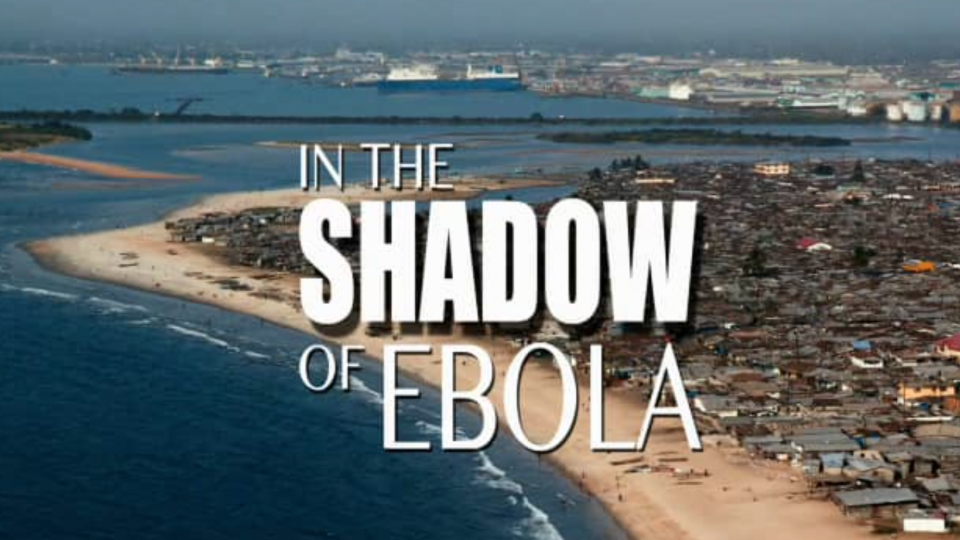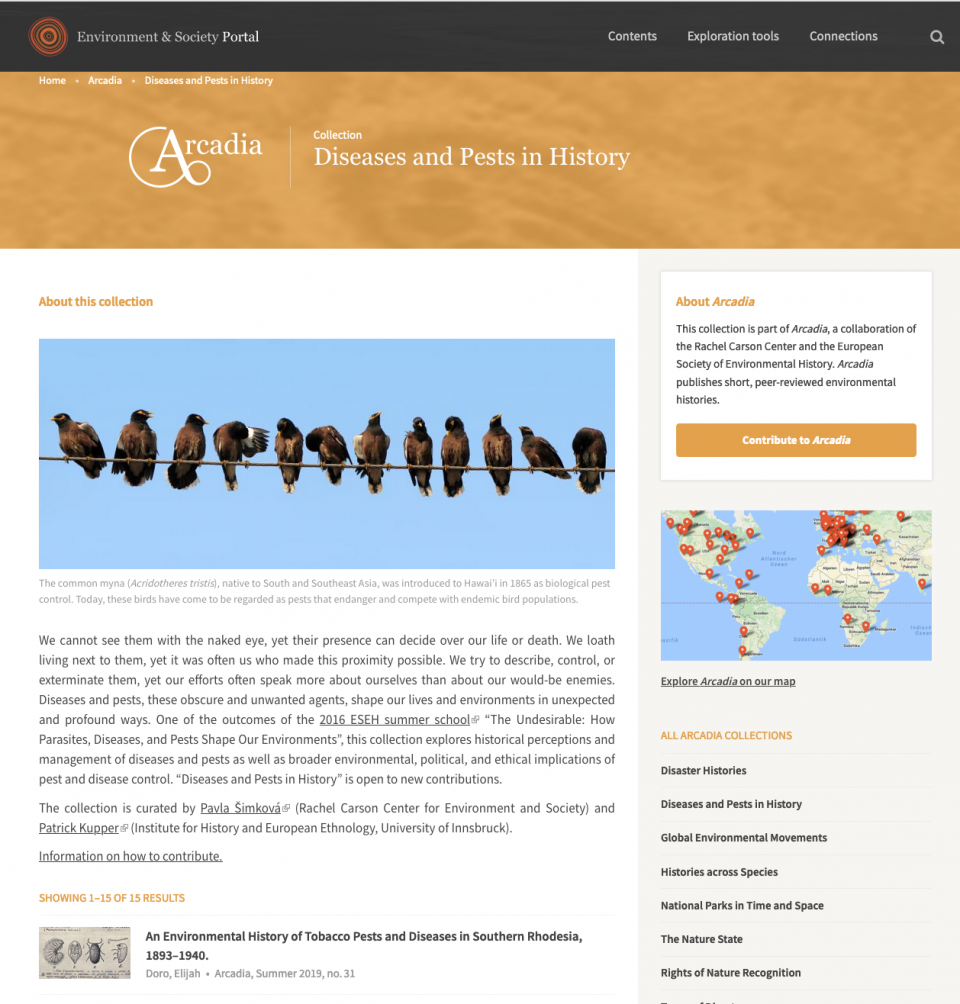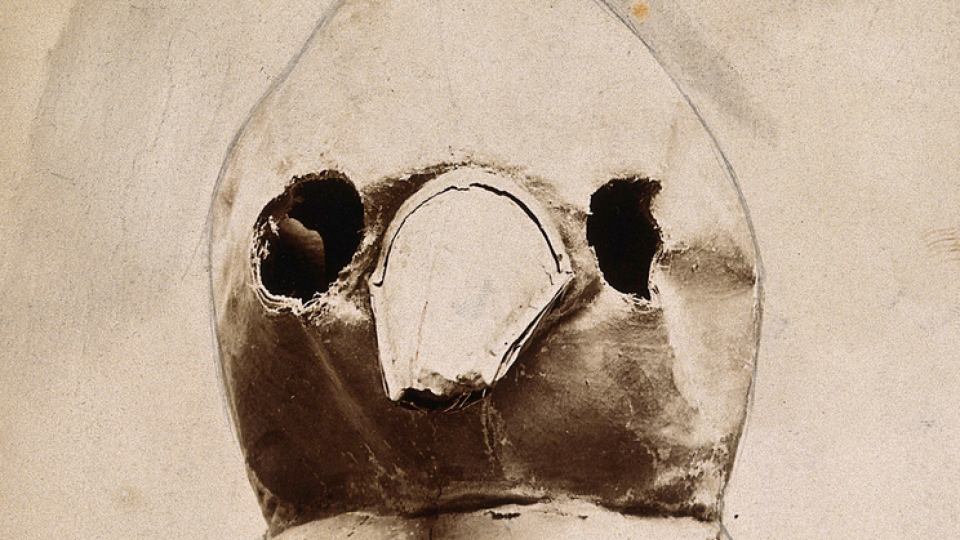
Seventeenth-century personal protective equipment from a lazaretto in Venice: an oilcloth mask with a bronze beak.
Seventeenth-century personal protective equipment from a lazaretto in Venice: an oilcloth mask with a bronze beak.
Courtesy of the Wellcome Library.
Click here to view source.
 This work is licensed under a Creative Commons Public Domain Mark 1.0 License.
This work is licensed under a Creative Commons Public Domain Mark 1.0 License.
What can we learn from human responses to epidemics and pandemics in history? What insights can ecological and environmental humanities perspectives provide? This new and growing collection of annotated links to open-access media (analyses, primary sources, and digital resources) helps put pandemics in context. Click on/hover over images for more information.
“Geography of COVID-19” blog series (with many resource links) from Colorado State University by Carson Fellow alumna Melinda Laituri.
Ferris Jabr explains “How Humanity Unleashed a Flood of New Diseases” in this feature essay and audio story (35:25). New York Times 17 June 2020.
Seeing the Woods, the blog of the Rachel Carson Center for Environment and Society, is featuring a series of short COVID-19 essays by Carson fellow alumni. Jenia Mukherjee and Amrita Sen ask, “Is Covid-19 a “Capitalocene” Challenge?” Sigurd Bergmann examines our common post-corona future through a Swedish lens, and Serenella Iovino reflects on zoonosis as the viral bridge between species.
In “Another Silent Spring,” historian and Carson Fellow alumnus Donald Worster explains how human relations with other animals, wild and domestic, are at the core of a majority of epidemics. In the face of the current coronavirus crisis, he argues that an exclusive focus on human life and economy will keep neither the planet nor ourselves healthy. We must decide “whether we humans can or want to restore and protect the health, not just of ourselves, but also of the planet.” An earlier version appeared in Mandarin in 中華讀書報 (China Reading Weekly).
The Max Planck Institute fo the History of Science has launched a new online resource, History of Science ON CALL to aggregate research and education resources related to crises, including chronic disasters. The Research stream consists of 3–5-minute video contributions from scholars who ask questions related to their research field in the context of Covid-19, while the Education stream introduces resources and teaching tools.
In “Spreading Pestilence,” a chapter from Carson Fellow alumna Kate Rigby’s Dancing with Disaster, Rigby considers how socio-culturally intensified vulnerability to a lethal pandemic was prefigured by Mary Shelley in her dystopian novel, The Last Man (1826), in which the virtual extinction of humankind unfolds, uncannily for today’s readers, amidst an oddly disordered climate in the closing decades of this century. “Spreading Pestilence” is available on the Portal courtesy of the University of Virgina Press.
George Prochnik reflects on Heinrich Heine’s account from Paris of the unfolding of the 1832 cholera pandemic, asking how we can respond to the current crisis with lucidity and compassion. “Life in the Time of Cholera: Lessons on a Pandemic” (Emergence Magazine 2020).
In “How Pandemics Change History,” Isaac Chotiner interviews Frank Snowden, Andrew Downey Orrick Professor of History at Yale University (New Yorker, 3 March 2020). Prof. Snowden’s online “Open Yale Course” Epidemics in Western Society since 1600 includes twenty-six streamable lectures recorded in 2010. The course consists of an international analysis of the impact of epidemic diseases on western society and culture from the bubonic plague to HIV/AIDS and the recent experience of SARS and swine flu. Themes include: infectious disease and its impact on society; the development of public health measures; the role of medical ethics; plague literature; social reactions; the rise of the germ theory of disease; the development of tropical medicine; a comparison of the impact of major infectious diseases; and the issue of emerging and re-emerging diseases.
In “Destroyed habitat creates the perfect conditions for coronavirus to emerge” (Scientific American, 18 March 2020), John Vidal explains how humanity’s destruction of biodiversity creates the conditions for new viruses and diseases like COVID-19.
The World Economic Forum and Visual Capitalist publish a visual history of pandemics comparing some of history’s most deadly pandemics from the Antonine Plague to COVID-19.
In “‘You have to change your life!’ Our Common Post-Corona Future through a Swedish Lens,” former Carson Fellow Sigurd Bergmann discusses Sweden’s response to the Corona crisis. Can we and, perhaps more importantly, do we want to learn from this situation?

Giant ground pangolin (Smutsia gigantean). Photograph by David Brossard, 2016.
Giant ground pangolin (Smutsia gigantean). Photograph by David Brossard, 2016.
2016 David Brossard
 This work is licensed under a Creative Commons Attribution-ShareAlike 2.0 Generic License.
This work is licensed under a Creative Commons Attribution-ShareAlike 2.0 Generic License.
Starting with the trafficking of the scaly anteater, philosopher, writer, and former Rachel Carson Fellow Thom van Dooren explains how the current pandemic is a symptom of a broader problem: “an increasingly dysfunctional relationship between human communities, other animals, and the broader environment.” Thom van Dooren, “Pangolins And Pandemics: The Real Source Of This Crisis Is Human, Not Animal,” newmatilda.com (22 March 2020).
In “’This is not the bat’s fault’: A disease expert explains where the coronavirus likely comes from,” Brian Resnick interviews veterinarian and an epidemiologist Jonathan Epstein about the COVID-19 pandemic (Vox 12 February 2020). Epstein outlines what’s known about the source of the new outbreak, the challenge of preventing outbreaks, and why zoonotic disease (i.e. disease that passes between animals and humans) is a two-way street.
In “Coronavirus holds key lessons in how to fight climate change” (Yale Environment 360, 23 March 2020), Beth Gardiner discusses parallels between the COVID-19 pandemic and the climate crisis, and a main lesson: if you wait to react until you can see the impact, it’s too late to stop it.
Northeastern University Profs. Sari Altschuler and Elizabeth Maddock Dillon have compiled a community-sourced Humanities Coronavirus Syllabus with focus on epidemics in literature, arts, philosophy, and religion, and many links to digital media. Shared with permission; contributions are welcome.
Teaching COVID-19: An Anthropology Syllabus Project is a developing document designed to collect and share resources for anthropologists and other social scientists teaching about COVID-19. Shared with permission; contributions are welcome.
On his podcast “Slow Disaster,” historian Scott Knowles hosts COVID-Calls, conversations with international experts on history and humanities aspects of the current pandemic.
Duke University Press has created a Navigating the Threat of Pandemic Syllabus in which books are free to read online until 1 June 2020, and journal articles are free until 1 October 2020.
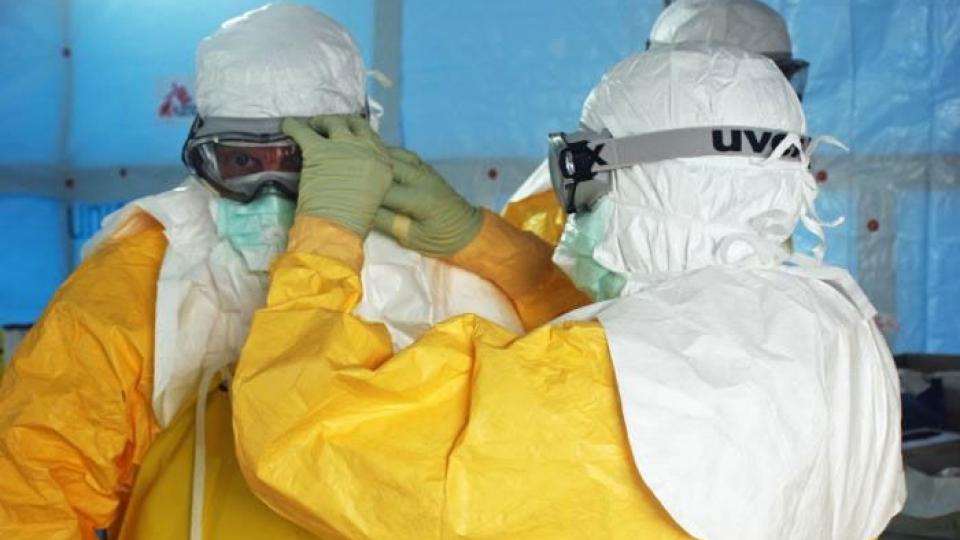
Healthcare workers in Liberia during the 2014 Ebola outbreak. Photo: CDC/Sally Ezra/Athalia Christie
Healthcare workers in Liberia during the 2014 Ebola outbreak. Photo: CDC/Sally Ezra/Athalia Christie
 This work is licensed under a Creative Commons Public Domain Mark 1.0 License.
This work is licensed under a Creative Commons Public Domain Mark 1.0 License.
In “Learning from Epidemics” (University of Wisconsin–Madison, 17 March 2020), Mary Ellen Gabriel interviews Gregg Mitman, historian of medicine, Affiliated Professor at LMU’s Rachel Carson Center for Environment and Society, and filmmaker of In the Shadow of Ebola. Mitman discusses historical parallels to the COVID-19 pandemic, as well as issues of public trust and economic impact. On 1 April 2020 Mitman was interviewed for the podcast Science! With Friends in a segment titled “Pandemics: A letter from the past.”
In the Shadow of Ebola is an intimate story of a family and a nation struggling against the Ebola outbreak in Liberia. Gregg Mitman, former Rachel Carson Fellow and award-winning author, filmmaker, and teacher, follows a Liberian student and his family living divided between the United States and Liberia. As the crisis unfolds, loved ones are isolated in Monrovia where the government is shut down, schools and markets are closed, and food prices are rising. The director’s cut (26 minutes) is free to stream.
The Harvard University Library Open Collections Program’s Contagion: Historical Views of Diseases and Epidemics offers important historical perspectives on the science and public policy of epidemiology today and contributes to the understanding of the global, social–history, and public–policy implications of diseases.
“Visual Representation of the Third Plague Pandemic” is a research project led by medical anthropologist Christos Lynteris and funded by the European Research Council and includes a database of plague photography. The project collects and analyzes photographs as well as other visual documents of the third plague pandemic, which broke out in 1855 in Southwest China (Yunnan) and raged across the globe until 1959, causing the deaths of approximately 12 million people.
Teach3.11 x COVID-19 is a collective of educators, researchers, artists, students and survivors spanning disciplinary and linguistic boundaries who study and teach about disasters.
In this COVID-19 webinar by the Moore Institute at NUI Galway (2 April 2020), the first in a series, four Humanities scholars offer perspectives on COVID-19, raise questions regarding environmental issues and Eurocentrism, and discuss lessons that can be learned from the Global South.
Gari, Lutfallah. “Arabic Treatises on Environmental Pollution up to the End of the Thirteenth Century.” (Environment and History 2002). Ever since the earliest Arabic writings on medicine we meet treatises on widespread illnesses or crowd diseases, including epidemics. This paper is limited to the works that deal with environmental pollution as a cause of such illnesses.
In “Ecology, Epidemics and Empires: Environmental Change and the Geopolitics of Tropical America, 1600–1825,” (Environment and History 1999), John McNeill looks at how yellow fever attacked different populations differently in the Atlantic American tropics, from Florida to Brazil. It killed outsiders more easily than locals, whites more easily than blacks, adults more easily than children. This meant that, after yellow fever was firmly ensconced via an ecological reconfiguration connected to sugar (c. 1640–90) it underpinned a military and political status quo, keeping Spanish America Spanish. After 1780, and particularly in the Haitian revolution, yellow fever undermined that status quo by assisting independence movements in the American tropics.
In 2001 foot and mouth disease broke out in the UK and spread rapidly. In “Biosecurity and Insecurity: The Interaction between Policy and Ritual During the Foot and Mouth Crisis,” (Environmental Values 2006), Brigitte Nerlich and Nick Wright show that the biosecurity measures farmers implemented during the epidemic meant more than just reducing the risk of spreading FMD. Biosecurity actions became invested with symbolic values and, in particular, were ritualised as part of the symbolic spatial construction of an otherwise ‘invisible’ enemy.
In “Divine Punishment or Object of Research? The Resonance of Earthquakes, Floods, Epidemics and Famine in the Correspondence Network of Albrecht von Haller,” (Environment and History 2003), Martin Stuber examines the resonance of disasters in the correspondence network of the universal scholar Albrecht von Haller (1708–77). In this European system of communication there is a very rapid exchange of widely dispersed individual observations and an intensive discussion about competing interpretations. Although earthquakes are the main focus of attention, letters also discuss cattle diseases, plagues, famines and floods.

Lübecker Totentanz [Lübeck’s dance of death]. 1701 copy of Bernt Notke’s original from c. 1460.
Lübecker Totentanz [Lübeck’s dance of death]. 1701 copy of Bernt Notke’s original from c. 1460.
Copy by Anton Wortmann, 1701.
Original artwork by Bernt Notke, c. 1460.
 This work is licensed under a Creative Commons Public Domain Mark 1.0 License.
This work is licensed under a Creative Commons Public Domain Mark 1.0 License.
In “Flea and ANT: Mapping the mobility of the Plague, 1330s–1350s” (postmedieval 2013), Kathleen Coyne Kelly employs Bruno Latour’s Actor-Network Theory (ANT) as a heuristic for thinking about the fourteenth-century Plague as well as about the interdiscipline of plague studies. Examining medieval narrative “maps” of the mobility of the Plague, modern geographical maps, computer simulations of the movement of the Plague, and maps of the Y. pestis and rat genome demonstrates different types and scales of mobility, and also raises questions about the place of humanists in plague studies.
The online Ancient History Encyclopedia offers accessible summaries of disease events such as Justinian’s Plague (541–542 CE) by John Horgan.
Created with support from the CDC, National Endowment for the Humanities, University of Michigan and the Robert Wood Johnson Foundation, the digital Influenza Encyclopedia is an archive of historical documents and photographs pertaining to the American influenza epidemic of 1918–19 and includes stories of 50 cities.
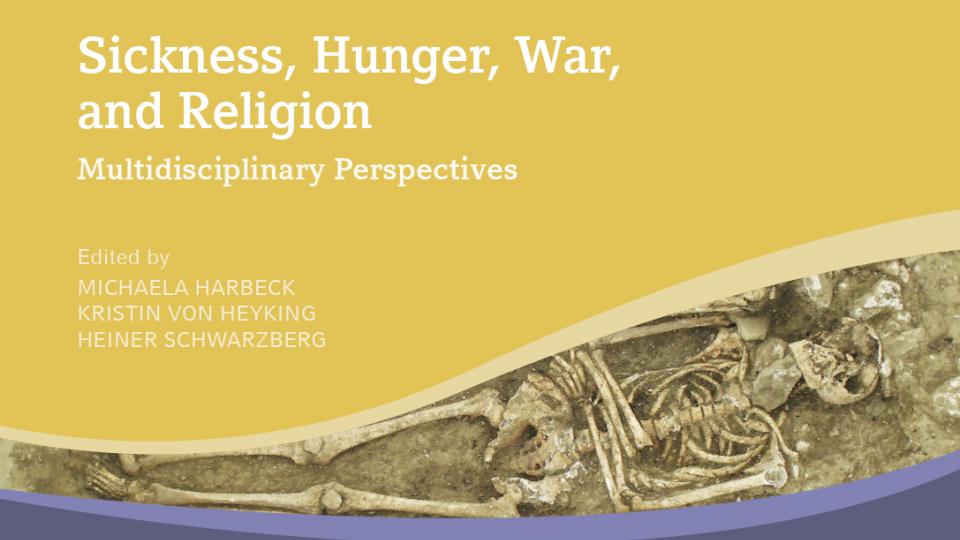
Rachel Carson Center.
 This work is licensed under a Creative Commons Attribution 4.0 International License.
This work is licensed under a Creative Commons Attribution 4.0 International License.
The 2012 RCC Perspectives volume, “Sickness, Hunger, War, and Religion: Multidisciplinary Perspectives” presents syntheses of research in the fields of archaeology, anthropology, and history. In the section “History of the Plague,” Ole Jørgen Benedictow, Raffaella Bianucci, Sacha Kacki, and Ingrid Wiechmann offer paleobiological and archaeological perspectives on the Plague and the bacteria Yersinia pestis.
Rachel Carson Center’s open-access journal Arcadia: Explorations in Environmental History features a special collection on “Diseases and Pests in History.” The collection explores historical perceptions and management of diseases and pests as well as broader environmental, political, and ethical implications of pest and disease control. It is curated by Pavla Šimková and Patrick Kupper. Arcadia has also published other relevant articles such as Kseniya Barabanova’s “The First Cholera Epidemic in St. Petersburg” and Cindy Ermus’s “The Plague of Provence: Early Advances in the Centralization of Crisis Management.”
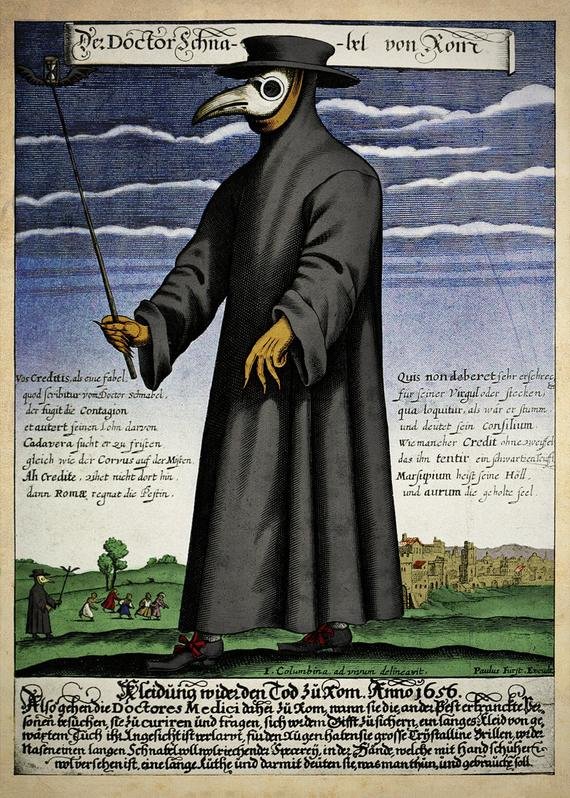
Copper engraving of Doctor Schnabel [i.e Dr. Beak], a plague doctor in seventeenth-century Rome, with a satirical macaronic poem (‘Vos Creditis, als eine Fabel, / quod scribitur vom Doctor Schnabel’) in octosyllabic rhyming couplets. View source on Wikimedia.
Copper engraving of Doctor Schnabel [i.e Dr. Beak], a plague doctor in seventeenth-century Rome, with a satirical macaronic poem (‘Vos Creditis, als eine Fabel, / quod scribitur vom Doctor Schnabel’) in octosyllabic rhyming couplets. View source on Wikimedia.
 This work is licensed under a Creative Commons Public Domain Mark 1.0 License.
This work is licensed under a Creative Commons Public Domain Mark 1.0 License.
Linking policy
The Environment & Society Portal provides links to third party sites that are not under the Portal’s control. These links are provided as a convenience and for informational purposes only; they do not indicate the Portal’s endorsement of or sponsorship of the third party or its website content, including any advertisements that may be posted. The Portal has no control over and bears no responsibility for the accuracy or legality of externally linked content. The Environment & Society Portal encourages other websites’ use of hyperlinks to direct visitors to the Portal home page or other Portal pages. Such links shall not imply or infer that the linking organization, its products, or services are endorsed by the Environment & Society Portal or the Rachel Carson Center for Environment and Society.


